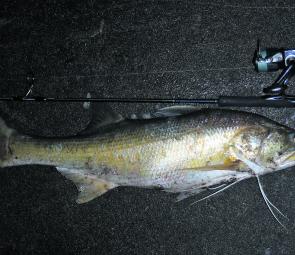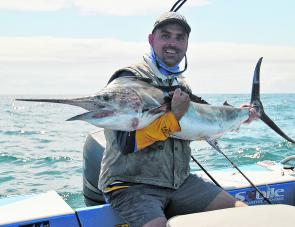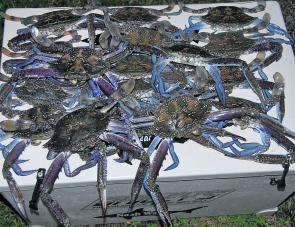For many anglers, and kids, December is an exciting time. The fishing is fantastic, Santa is coming with lots of new tackle and many lucky anglers are on annual holidays.
December weather can be kind with numerous hot and glassed-out days. A large array of seafood treats are on offer with numerous pelagic, crustacean and demersal species coming to the fore. Whether you are keen for some game and sport fishing action or just in the hunt for a seafood feast to pamper your Christmas guests, December offers you plenty of awesome angling opportunities.
Last year was a bumper one for crabs with good numbers of mud and sand crabs being caught.
Setting a few pots around the margins of the bay islands was usually extremely successful for those chasing a feed of succulent sandies. Even the occasional mud crab was taken in these zones after the heavy rains, which caused flooding in many of the river systems.
This generally flushes the mud crabs from well up the systems and out into the bay or at least around the river mouths. Here they are much easier to target and I scored several quality muddies every time we put pots in around the mouth of the Brisbane River.
Most systems produced good numbers of quality muddies for those making the effort. During normal conditions however, muddies are generally located well up the system, even in the smallest drains and gutters feeding in from the mangrove flats. Those who go to the effort to set pots in the harder to access locations are likely to score the best hauls and biggest muddies.
Having a small tinnie or kayak at your disposal could definitely make setting your pots in these zones a lot easier.
I primarily use mullet or chunks of mac tuna to bait my pots however a broad array of baits will work for sand and mud crabs. Try chicken carcasses, left over fish frames or even a few pillies in a bait envelope.
Regulations on crab pots and their labelling are worth checking because fines are fairly stiff. Inadequately or non-labelled pots are often removed from the waterways by fisheries which can be an expensive loss.
Sand crabbing throughout Moreton Bay was awesome last year with good hauls of quality males taken by virtually all who threw a few pots in the water. My best haul was 27 legal bucks for five hours of crabbing with four pots and we scored at least double figures every time we went to the effort.
Setting pots wide of the bay islands along prominent contours or ledges generally produced the goods. Each location was a little different depending on tidal phase however I set my pots in depths between 4m and 7m.
Deeper channels are also productive locations, especially those that separate the bay islands. Other good spots to try are the flats out the front of Wynnum and Manly, the edges of the numerous banks throughout Moreton Bay and around the mouths of major river systems.
Sand and mud crabs require different ways of measuring and different sizes so check the regulations and get a crab measuring device before heading out.
The pelagic action offshore was amazing last year during December and January.
Although there was a broad array of pelagics on offer, it was the juvenile black marlin that most anglers were targeting and talking about. These were available in almost ridiculous numbers and generally if you had a few skirted trolling lures in the water then you had an awesome chance of getting connected.
Some of the prime areas were just north of the Seaway Bar, around the Point Lookout area, Hutchinson Shoals, The Trench and most waters in between. There was plenty of bait and awesome numbers of little black marlin, which were predominately between 15-25kg in weight, with the occasional specimen boated to 60kg.
Small skirted trolling lures were the go with popular offerings being Bahama 20s, Black Snacks, Meridian size 5 (Quasi, Salt Shaker, Ahi and Demon), Hollowpoint Teeny Magnums, Pakula (Micro Roach, Micro Sprocket, Fluzi and Uzi), Bonze Bruisers and numerous others.
Most anglers fishing 6-10kg tackle rigged these on the thin Gamakatsu SL12S hooks for maximum hook setting on these small fish. Heavier tackle dictated a stronger hook, such as a Maruto 1920s or a Mustad 7691Z. I mainly fished 6kg line last season however most opted for 8-10kg line. Be careful fishing any heavier than this as you will have a green (lively) fish at the boat fairly quickly, which can be very dangerous when their front end possesses a sharp spear-like bill.
Other pelagics can be encountered while trolling for small marlin included mahi mahi, sailfish, wahoo, yellowfin tuna, mac tuna and Spanish mackerel, however specific targeting in certain locations could increase your results on these.
School mackerel numbers have been fairly good over the last few months, however December should see better numbers of spotted mackerel entering Moreton Bay.
Last year was an extremely poor one for spotties in our area but I am hopeful of better results this season. Surface feeding schools are commonly located along the edges of the shipping channels and more open areas of the bay.
Anglers fishing the paddock between Mud Island and the Sand Hills should be aware of the Green Zone as several anglers were fined in this zone last year as they were unaware there was even one there. With mackerel often schooling in this general area, it is easy to accidentally venture into the Green Zone when traversing from one bust up to another.
The surface feeding schools are generally targeted with chromed slugs and slices cast and retrieved flat-stick with high-speed reels. However there are numerous other offerings that can work. Stick baits, jerk shads, flies, blades and several others will attract strikes from ravenous mackerel. However, there is no denying the casting attributes and minimal cost of chromed slugs and slices when you are targeting a fish with razor sharp dentures.
Adding a little wire to your rig can definitely increase the chance of landing any hook mackerel, however the initial hook up rate will be much lower when using wire.
Tips for decreasing the likelihood of a bite off include not casting directly into the mayhem, instead aim to the side of it. Beginning your retrieve before the lure actually lands on the water means it is already moving when it lands and is less likely to be entirely engulfed because mackerel will slash at the tail of fast moving prey to immobilise it.
If surface feeding schools are not present, try drifting some whole pilchards rigged on ganged hooks around the beacons in the northern bay, the Curtin and Harry Atkinson artificial reefs and the bay islands.
The Measured Mile beacons are popular amongst small boat owners as they are not too far out from the mouth of the Brisbane River and are renowned for producing mackerel for those fishing pilchard baits in the general vicinity.
Early morning high tides offer some of the best fishing for both school and spotted mackerel in this location. Jigging beacons with chromed slugs is another popular and productive way to tempt them when the tide is running hard. Drop the lure close to the beacon and allow it to sink to the bottom before beginning a flat stick retrieve. Differing size and bag limits apply to both school and spotted mackerel so learn to identify each before heading out to chase them.
There will be plenty of other pelagics on offer for those fishing throughout Moreton Bay over the next few months. Longtail tuna, mac tuna, frigates, bonito and cobia will be the main ones on offer.
Any surface feeding commotion is worth checking out and although it may not be a highly desired and tasty mackerel, it could still provide you with a lot of fun if it is one of the lesser tuna or bonito species.
You may even come up trumps with a tasty sashimi torpedo in the form of a longtail tuna. These fish can often be extremely profile orientated so it pays to have several different sizes of chromed slugs and jerk-shad style plastics at your disposal.
Cobia can often be located around heavily structured areas such as coffee rock ledges, bay beacons, artificial reefs and submerged wrecks. These respond best to large live baits but are also taken on large plastics, blades, micro jigs and other lures on occasion.
Although it is a very popular spot during the holiday period, the Brisbane River continues to fish well. It offers a fairly sheltered waterway during periods of bad weather and there is a plethora of spots along its length to fish.
Common species include bream, flathead, king threadfin salmon, mulloway, estuary cod, snapper and a host of less desirables in the form of rays, sharks, catfish and pike eels.
A cast net can secure you some live baits from adjacent the sewerage shute, in the creeks (Boggy, Aquarium Passage, Breakfast, Norman, Oxley, etc.) or the shallows around White Island.
Live mullet, prawns, herring and gar will tempt most of the more desirable species, especially the larger predators such as king threadfin salmon, cod, mulloway and snapper. These are fished along the edges of the drop-off into the main river bed, adjacent to the numerous jetties, along the rock wall at the mouth and renowned spots such as Claras Rocks, The Gateway Bridge and the Sunken Wall.
Lure fishing is also popular and productive at these same spots and anglers commonly use soft plastics, blades, vibration baits and numerous other offerings.
Those with a good knowledge of their sounder can often locate and catch quantities of banana prawns and setting a few pots is also likely to reward you with mud or sand crabs.
The summer months still produce some respectable snapper fishing. Although numbers may be down on the cooler months there are still plenty of quality specimens around to make the effort worthwhile.
The usual techniques of fishing well presented (fresh or live) baits or casting lures such as plastics, blades and vibration baits still applies.
The larger snapper are often found feeding fairly close to the surface around the bay islands and at times their fins or tail may break the surface as they harass gar and hardiheads.
Snapper can also often be found in fairly open water around the edges or under bait schools being set upon by pelagics. Here they commonly clean up the scraps left after the melee and a lightly weighted soft plastic casting into this zone and allowed to sink down will often be engulfed.
Shark activity can be fairly frantic during the warmer months with the bay and contributing rivers and creeks all producing numbers of veracious whalers and the occasional tiger, white or hammerhead.
The whalers are the most common and can provide a lot of fun for those fishing relatively light. They provide a good target to teach junior or novice anglers the skills involved in fighting a tough adversary. Most are less than 10kg in weight, which are the prime size if you want one for the table.
These can easily be handled on lighter line classes between 3kg and 8kg as they are not dirty fighters and patience will eventually allow you to secure them. However, be aware that they are very strong (even when you think they are tired out) and should be handled carefully to avoid injury.
Most whole fish baits and fillet baits will work well on these within the bay. However I prefer a live bait such as whole mullet, pike or small catfish when fishing in the creeks and rivers as a struggling bait is more likely to be found by the whalers and isn’t prone to be annoyed by pickers such as bream, crabs and the like.
A snelled circle hook rig on nylon coated wire has been very successful for me. You are now no longer allowed to keep a shark or ray larger than 1.5m, which has resulted in their numbers flourishing in recent years.
Well as you can tell there are plenty of fantastic fishing targets for you throughout December. With plenty of anglers on annual holidays there may be a few more boats on the water during the week, especially when weather conditions are favourable.
It is a great time to get the family out into the great outdoors no matter whether you are going out in a boat, to the beach or just fishing from the bank of a coastal or inland waterway. You will need to slip, slop and slap to swerve the effects of the scorching sun and keep up your fluid intake to avoid dehydration.
All in all the coming months promise some awesome action, especially if the large schools of mackerel enter Moreton Bay. Regardless there are plenty of awesome angling targets on offer in Moreton bay and the numerous creeks and rivers that feed into it.
Hopefully Santa will bring you some exciting new tackle to try out as well. Wishing everyone a festive holiday season and a safe, enjoyable and productive time on the water during December. See you in 2014.
Reads: 1336
King threadfin salmon are fairly common in the Brisbane River. This specimen was taken while casting lures at night from a land-based platform.

Hopefully the hordes of small black marlin, which swarmed to our waters last year, will again be a feature during the warmer months.

Sand crab numbers have been healthy throughout Moreton Bay during the last year and good hauls of these succulent crustaceans can be caught during the summer months.




